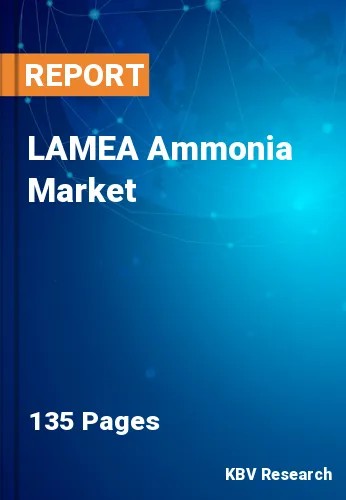The Latin America, Middle East and Africa Ammonia Market would witness market growth of 6.2% CAGR during the forecast period (2023-2030). In the year 2026, the LAMEA market's volume is expected to surge to 27,335.2 Kilo Tonnes, showcasing a growth of 5.4% (2023-2030).
The growth is primarily driven by consumers' increasing awareness of sustainable products, which has led to a desire for them. Growing awareness of the need to produce renewable energy and reduce carbon emissions increases demand for these products. Consequently, the market has become established, with growing demand from industries such as electricity production, refrigeration, transportation, and fertilizer.
The product has acquired traction in the transportation industry, specifically maritime shipping. Due to this, market participants are under pressure to lower their carbon footprint and shift to sustainable fuel sources. Green ammonia is the most effective fuel in terms of storage, cost, and availability compared to other fuels. The imperative to lower carbon emissions is the market's primary force. Green ammonia, which is expected to grow into a commodity chemical in the coming years, can potentially eliminate the carbon footprint of chemical production. In addition, government policies, subsidies, and regulations encourage the production and consumption of green ammonia.
Saudi Arabia is a major ammonia producer with numerous ammonia production facilities. These facilities are often integrated with petrochemical and fertilizer plants, utilizing locally available natural gas resources as a feedstock for ammonia production. Ammonia is a vital feedstock for producing various petrochemicals, including urea, ammonium nitrate, and other nitrogen-containing compounds. The Saudi petrochemical industry relies on ammonia as a precursor for manufacturing a wide range of chemical products. Saudi Arabia has a significant agricultural sector, and ammonia-based fertilizers are essential for optimizing crop yields in the region. Ammonia produced in the country supports both domestic agriculture and international export markets. Thus, the region presents lucrative prospects for the growth of the market.
The Brazil market dominated the LAMEA Ammonia Market, By Country in 2022, and would continue to be a dominant market till 2030; thereby, achieving a market value of $8,950.7 million by 2030. The Argentina market is showcasing a CAGR of 5.5% during (2023 - 2030). Additionally, The South Africa market would register a CAGR of 6.9% during (2023 - 2030).
Based on Product Form, the market is segmented into Anhydrous, and Aqueous. Based on Application, the market is segmented into Fertilizers, Refrigerants, Pharmaceuticals, Textile, and Others. Based on countries, the market is segmented into Brazil, Argentina, South Africa, Nigeria, Morocoo, Chile, and Rest of LAMEA.
Free Valuable Insights: The Worldwide Ammonia Market is Projected to reach USD 306.7 Billion by 2030, at a CAGR of 5.6%
The market research report covers the analysis of key stake holders of the market. Key companies profiled in the report include SABIC (Saudi Arabian Oil Company), Linde PLC, Yara International ASA, Nutrien Limited, BASF SE, Sumitomo Chemical Co., Ltd., Koch Industries, Inc. (Molex LLC), CF Industries Holdings, Inc., Qatar Fertiliser Company (Industries Qatar), and PJSC Togliattiazot.
By Product Form (Volume, Kilo Tonnes, USD Million, 2019-2030)
By Application (Volume, Kilo Tonnes, USD Million, 2019-2030)
By Country (Volume, Kilo Tonnes, USD Million, 2019-2030)
Our team of dedicated experts can provide you with attractive expansion opportunities for your business.

